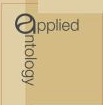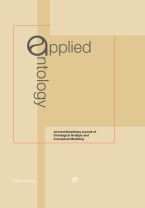Applied Ontology will be migrating to a new Editorial Manager submission peer review platform in the near future. We ask that authors of new submissions will direct their paper to the new platform when the migration has been completed.
All correspondence concerning editorial matters as well as information regarding submissions should be sent to the Assistant Editor:
Mihai Pomarlan
Faculty of Linguistics
University of Bremen
Bibliothek Strasse 1
28259 Bremen
Germany
Tel.: +49 17627951142
Email: pomarlan at uni-bremen.de
Authors are requested to submit their manuscript electronically through the journal’s editorial management system accessible by this website ("Submit Manuscript").
Note that the manuscript should be uploaded as one .pdf file with tables and figures included within the text.
Required files (after the acceptance of the paper)
After the article has been accepted, the following electronic files are required:
a word processor file of the text, such as Word or LateX. If using LaTex please use our LaTeX template and also send a pdf version of the LaTeX file separate files of all figures (if any); see "Preparation of manuscripts" for the required file formats. If using Word please use our Word template.
Colour figures
It is possible to have figures printed in colour, provided the cost of their reproduction is paid for by the author. See Preparation of Manuscripts for the required file formats.
Open Access option
The IOS Press Open Library® offers authors an Open Access (OA) option. By selecting the OA option, the article will be freely available from the moment it is published, also in the pre-press module. In the Open Library® the article processing charges are paid in the form of an Open Access Fee. Authors will receive an Open Access Order Form upon acceptance of their article. Open Access is entirely optional.
See also our website for more information about this option IOS Press Open Library®
IOS Pre-press
This journal publishes all its articles in the IOS Press Pre-Press module. By publishing articles ahead of print the latest research can be accessed much quicker. The pre-press articles are the corrected proof versions of the article and are published online shortly after the proof is created and author corrections implemented. Pre-press articles are fully citable by using the DOI number.
As soon as the pre-press article is assigned to an issue, the final bibliographic information will be added. The pre-press version will then be replaced by the updated, final version
PREPARATION OF MANUSCRIPTS
Organization of the paper and style of presentation
Manuscripts must be written in English and American spelling should be used consistently throughout the manuscript. Authors whose native language is not English are recommended to seek the advice of a native English speaker, if possible, before submitting their manuscripts.
International Science Editing offers a language and copyediting service to all scientists who want to publish their manuscript in scientific peer-reviewed periodicals and books.
Manuscripts should be prepared with wide margins and double spacing throughout, including the abstract, footnotes and references. Every page of the manuscript, including the title page, references, tables, etc., should be numbered. However, in the text no reference should be made to page numbers; if necessary, one may refer to sections. Try to avoid the excessive use of italics and bold face.
Manuscripts should be organized in the following order:
- Title page
- Body of text (divided by subheadings)
- Acknowledgements
- References
- Tables
- Figure captions
- Figures
Headings and subheadings should be numbered and typed on a separate line, without indentation.
SI units should be used, i.e., the units based on the metre, kilogramme, second, etc.
Title page
The title page should provide the following information:
- Title (should be clear, descriptive and not too long)
- Name(s) of author(s); please indicate who is the corresponding author
- Full affiliation(s)
- Present address of author(s), if different from affiliation
- Complete address of corresponding author, including tel. no., fax no. and e-mail address
- Abstract; should be clear, descriptive, self-explanatory and not longer than 200 words, it should also be suitable for publication in abstracting services
- Keywords.
Tables
Number as Table 1, Table 2 etc, and refer to all of them in the text.
All tables should be contained within the manuscript itself, and embedded in the text.
Each table should have a brief and self-explanatory title.
Column headings should be brief, but sufficiently explanatory. Standard abbreviations of units of measurement should be added between parentheses.
Vertical lines should not be used to separate columns. Leave some extra space between the columns instead.
Any explanations essential to the understanding of the table should be given in footnotes at the bottom of the table.
Figures
Number figures as Fig. 1, Fig. 2, etc and refer to all of them in the text.
All figures and other graphics should be contained within the manuscript itself, and embedded in the text.
Colour figures can be included, provided the cost of their reproduction is paid for by the author.
For the file formats of the figures please take the following into account:
- line art should be have a minimum resolution of 600 dpi, save as EPS or TIFF
- grayscales (incl photos) should have a minimum resolution of 300 dpi (no lettering), or 500 dpi (when there is lettering); save as tiff
- do not save figures as JPEG, this format may lose information in the process
- do not use figures taken from the Internet, the resolution will be too low for printing
- do not use colour in your figures if they are to be printed in black & white, as this will reduce the print quality (note that in software often the default is colour, you should change the settings)
- for figures that should be printed in colour, please send a CMYK encoded EPS or TIFF
Figures should be designed with the format of the page of the journal in mind. They should be of such a size as to allow a reduction of 50%.
On maps and other figures where a scale is needed, use bar scales rather than numerical ones, i.e., do not use scales of the type 1:10,000. This avoids problems if the figures need to be reduced.
Each figure should have a self-explanatory caption. The captions to all figures should be typed on a separate sheet of the manuscript.
Photographs are only acceptable if they have good contrast and intensity.
References
Authors are requested to use the APA (American Psychological Association) citation style. APA in-text citations should include the author's last name followed by the year of publication. There are are two possibilities for in-text citations, as in the following examples:
-Name (year), as in: "Author(2017) claims that..." (command in latex: \cite{name});
-(Name, year), as in "Such theory has been proven correct (Author, 2017)" (command in latex: \citep{name}).
We encourage authors to use the former format whenever possible.
All publications cited in the text should be presented in an alphabetical list of references at the end of the manuscript. Submitted articles can be listed as (author(s), unpublished data). See their website for more information. Authors are responsible for checking the accuracy of all references. Manuscripts will not be considered if they do not conform to the APA citation guidelines.
References must be listed alphabetically in APA style:
Anderson, A. K. (2005). Affective influences on the attentional dynamics supporting awareness. Journal of Experimental Psychology: General, 154, 258–281.
Anderson, A. K., Christoff, K., Panitz, D., De Rosa, E., & Gabrieli, J. D. E. (2003). Neural correlates of the automatic processing of threat facial signals.Journal of Neuroscience, 23, 5627–5633.
Armony, J. L., & Dolan, R. J. (2002). Modulation of spatial attention by fear-conditioned stimuli: An event-related fMRI study. Neuropsychologia, 40, 817–826.
Beck, A. T., Epstein, N., Brown, G., & Steer, R. A. (1988). An inventory for measuring clinical anxiety: Psychometric properties.Journal of Consulting and Clinical Psychology, 56,893–897.
Calvo, M. G., & Lang, P. J. (2004). Gaze patterns when looking at emotional pictures: Motivationally biased attention.Motivation and Emotion, 28, 221–243.
Carretie, L., Hinojosa, J. A., Martin-Loeches, M., Mecado, F., & Tapia, M. (2004). Automatic attention to emotional stimuli: Neural correlates.Human Brain Mapping, 22, 290–299.
COPYRIGHT
Copyright of your article
Authors submitting a manuscript do so on the understanding that they have read and agreed to the terms of the IOS Press Author Copyright Agreement.
Quoting from other publications
An author, when quoting from someone else's work or when considering reproducing figures or table from a book or journal article, should make sure that he is not infringing a copyright. Although in general an author may quote from other published works, he should obtain permission from the holder of the copyright if he wishes to make substantial extracts or to reproduce tables, plates or other figures. If the copyright holder is not the author of the quoted or reproduced material, it is recommended that the permission of the author should also be sought. Material in unpublished letters and manuscripts is also protected and must not be published unless permission has been obtained. Submission of a paper will be interpreted as a statement that the author has obtained all the necessary permission. A suitable acknowledgement of any borrowed material must always be made.
PROOFS
The corresponding author will receive a PDF proof and is asked to check this proof carefully (the publisher will execute a cursory check only). Corrections other than printer's errors, however, should be avoided. Costs arising from such corrections will be charged to the authors.
PURCHASES
How to order reprints, a PDF file, journals, or IOS Press books
The corresponding author of a contribution to the journal will receive a complimentary PDF Author’s Copy of the article, unless otherwise stated. This PDF copy is watermarked and for personal use only. A free PDF copy will not be provided for conference proceedings and abstract issues. An order form for a PDF file without watermark, reprints or additional journal copies will be provided along with the PDF proof.
If you wish to order reprints of an earlier published article, please contact the publisher for a quotation. IOS Press, Fax: +31 20 687 0019. Email: editorial@iospress.nl.
An author is entitled to 25 % discount on IOS Press books. See Author's discount (25%) on all IOS Press book publications.

